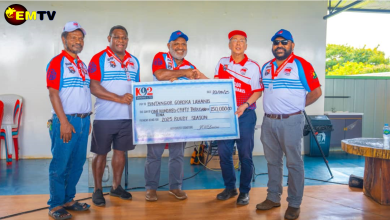Somali Islamists let drought-hit civilians roam in search of food
Image: Women carry jerry cans of water from shallow wells dug from the sand along the Shabelle River bed, which is dry due to drought in Somalia’s Shabelle region, March 19, 2016. REUTERS/Feisal Omar/File Photo
By Feisal Omar
MOGADISHU (Reuters) – Somali Islamists are letting civilians in drought-hit regions under their control move with relative freedom to find food, the group and a U.N. official said on Thursday, but they are continuing to restrict the access of international aid groups.
Somalia, struggling to recover from more than 25 years of civil war and an ongoing battle between its U.N.-backed government and Islamist insurgents, could sink into famine if the April rains fail.
About quarter of a million people died during the last famine in 2011, when al Shabaab’s restrictions on movement and its refusal to allow many aid groups access pushed up the death toll, aid groups say.
This time, the insurgents say people can move.
“We do not stop those who want to leave for other places, they are free,” Sheikh Suldan Aala Mohamed, the chairman of al Shabaab’s drought emergency committee, told Reuters.
FILE PHOTO: Children play on an abandoned boat along the Shabelle River bed, which is dry due to drought in Somalia’s Shabelle region, March 19, 2016. REUTERS/Feisal Omar/File PhotoAl Shabaab, an al Qaida linked Islamist group, has lost large swathes of territory in recent years to pro-government regional militias and African Union peacekeepers supporting the weak federal government.
Although it lost control of most major cities, it is still strong in parts of rural southern Somalia.
Justin Brady, the head of the U.N.’s Office for the Coordination of Humanitarian Affairs, said he had met several residents who recently left al Shabaab territory and were concerned they would be unable to return.
“If they return from areas of government control, they will be viewed with suspicion and subject to abuse,” Brady said.
“It will be unfortunate, if there are decent rains, that they cannot go back with tools and seeds.”
Brady said al Shabaab still restricted aid workers’ access. Death rates related to cholera and diarrhea in al Shabaab-held areas were 4.5 times higher than in government-held areas, the United Nations says.
“We cannot reach people with the most basic interventions such as water purification tablets, soap, or jerry cans to improve their water,” Brady said.
Cholera has broken out in 11 of 18 regions as wells dry up and families drink infected water.
Al Shabaab’s Mohamed said that international aid agencies in Somalia were ineffective and al Shabaab provided its own aid.
“They just talk and dying people need action to save them,” Mohamed said. “We have started giving food and water to the most drought-hit Somalis.”
He said that the insurgents used 70 trucks to supply water and provided food rations to 400 families on Thursday. Residents, though, were skeptical the militants could do enough.
“Al Shabaab gave us water and food and we have seen them taking food and water to others in the area, but the needs of the entire people cannot be met,” resident Abdullahi Mohamed said from Hindheer district in the central Galgadud region.
“Some people are in the jungle where there are no roads. Some are dying under trees,” he said.
The U.N. said it fed 1.1 million Somalis last month and provided clean water to 570,000.
(Additional reporting by Katharine Houreld; writing by Katharine Houreld; editing by Richard Lough)
Copyright 2017 Thomson Reuters. Click for Restrictions.






